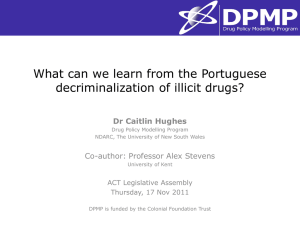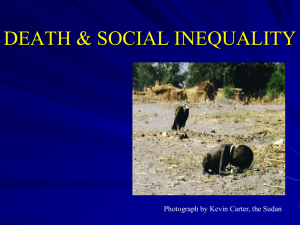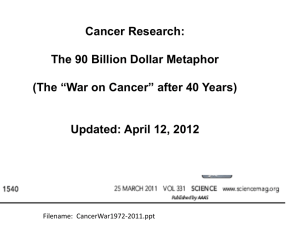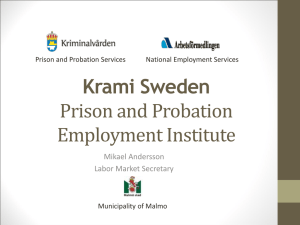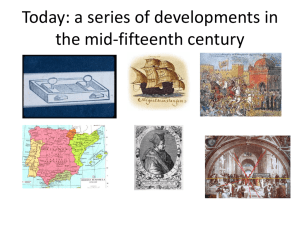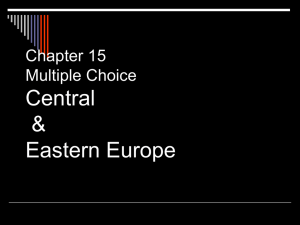the slideshow he presented
advertisement
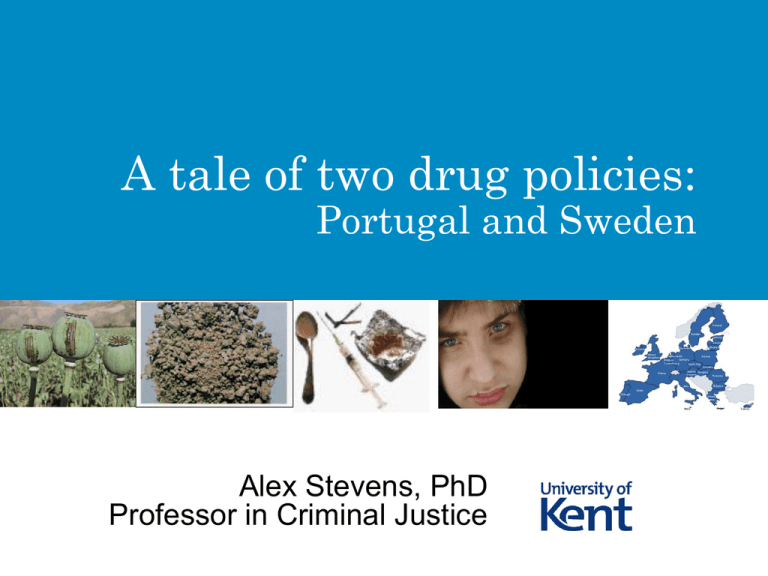
A tale of two drug policies: Portugal and Sweden Alex Stevens, PhD Professor in Criminal Justice Content • Key features of Portuguese and Swedish drug policies • Narratives of success (and failure) • Portugal: Trends since decriminalisation • Sweden Trends in drug use and harms • Need for broader analysis Key features of Portuguese policy • Decriminalisation of personal possession of all illicit drugs since 2001. But also: • • • • Referral to CDTs. Continued prosecution of dealers and traffickers. Expansion of treatment and harm reduction. Introduction of guaranteed minimum income. Portugal: Narrative of success (e.g. Greenwald 2009) • • • • • Drug use declined. Reduction in drug deaths. Lower prevalence of drug use in Portugal than other EU countries. [Little emphasis placed on treatment expansion, or lifetime drug use in adults.] Policy a ‘resounding success’. Portugal: Narrative of failure (e.g. Pinto Coelho 2010) • • • • • Drug use went up. Drug deaths went up. Drug related homicides went up. Portugal has highest rate of HIV in injecting drug users in the EU. Policy a ‘disastrous failure’ Evidence: drug use by young people Figure 1: Lifetime prevalence of cannabis amongst Portuguese school students, by year and survey 30 Prevalence of use 25 20 15 10 5 0 1998 2002 2006 1995 1999 2003 2007 2003 2007 2003 2007 2003 2007 2003 2007 2003 2007 2003 2007 2001 2006 2001 2006 6, 8 & 10th grades 16 yrs HBSC/OMS ESPAD 13 yrs 14 yrs 15 yrs 16 yrs ECTAD 17 yrs 18 yrs 7-9th grade 10-12th grade INME Source: Feijão (2008, 2009); and Feijão and Lavado (2003, 2004); Hibell et al. (2007); Matos et al. (2000, 2003, 2008). N.B. Only HSBC/OMS and ESPAD da Evidence policy Evidence: drug related deaths 400 80 350 70 300 60 250 50 200 40 150 30 100 20 50 10 0 0 2000 2001 2002 2003 2004 2005 2006 2007 Year Drug-related deaths - INML Source: Institute da Droga e da Toxicodependência (2009, 2010). Drug induced deaths - INE 2008 Drug-induced deaths (INE) Drug-related deaths (INML) Figure 4: Drug related deaths in Portugal between 2000 and 2008 using INML definition (positive post-mortem toxicological test for drugs) and INE definition (determination by physician according to ICD criteria) Evidence: Homicides Homicide rate (deaths per 100,000 inhabitants) 1.8 1.6 1.4 1.2 1 0.8 0.6 0.4 0.2 0 2000 2001 Source: Eurostat 2002 2003 2004 2005 2006 2007 2008 2009 2010 Evidence: HIV Incidence of HIV and AIDS among drug users, 2000-2008 1000 900 800 700 600 500 2000 400 2008 300 200 100 0 HIV Source: Hughes and Stevens 2010 AIDS Sweden: key features of drug policy • • • • Aim for a ‘drug free society’. Restrictive approach to drugs: Use of drugs criminalised (police testing) High rate of conviction of arrestees for drug possession. Use of compulsory treatment. But relatively low maximum prison sentences: 10 years for first offence (even large scale trafficking) Limited availability of harm reduction services. Sweden: Narratives of success? • UNODC 2007: ‘Countries get the drug problem they deserve’ Sweden has low prevalence of drug use, due to rigorous policy against drugs since the 1970s. • Counter-argument (Cohen, Olsson) UNODC conclusions not supported by evidence. Recent data shows worrying increase in drug related deaths and HIV in IDU. Sweden: historical drug use trends Source: UNODC 2007 (citing Olsson 1994) Sweden: drug related deaths Source: EMCDDA 2011 Sweden: IDUs testing positive for HIV Source: EMCDDA 2011 Broader analysis: welfare and youth drug use Conclusions: • • • • Decriminalisation in Portugal did not lead to an explosion in drug use. Restrictive policies in Sweden did not cause the reduction in drug use. Treatment and harm reduction services are associated with reductions in deaths and HIV incidence. Broader policies of welfare and imprisonment are associated with drug policy outcomes. More information • Publications: • Email: a.w.stevens@kent.ac.uk Hughes, C., & Stevens, A. (2012) A resounding success or a disastrous failure: Re-examining the interpretation of evidence on the Portuguese decriminalisation of illicit drugs, Drug and Alcohol Review, 31(1) 101—113. Stevens, A. (2011), Drugs Crime and Public Health: The Political Economy of Drug Policy. Abingdon: Routledge Hughes, C., & Stevens, A. (2010). What can we learn from the Portuguese decriminalisation of illicit drugs? British Journal of Criminology, 50(6), 9991022 Conclusion on Portugal “Considered analysis of the two most divergent accounts reveals that the Portuguese reform warrants neither the praise nor the condemnation of being a ‘resounding success’ or a ‘disastrous failure’, and that these divergent policy conclusions were derived from selective use of the evidence base that belie the nuanced, albeit largely positive, implications from this reform.” Source: Hughes and Stevens, 2012 Evidence: drug use Figure 2: Prevalence of lifetime, recent (last 12 month) and current (last month) use of any illicit drug in Portugal amongst individuals aged 15-64, 2001 and 2007 14 12 Prevalence of use 10 8 6 4 2 0 15-64 Lifetime use 15-64 15-64 Recent use Current use 2001 Source: Balsa et al. (2001; 2007). 2007 Evidence: prison population Sentenced prisoners for drugs and other offences 12,000 10,000 8,000 6,000 Non-drug offences Drug offences 4,000 2,000 0 Source: Council of Europe Annual Penal Statistics Broader analysis: prison and problematic use
